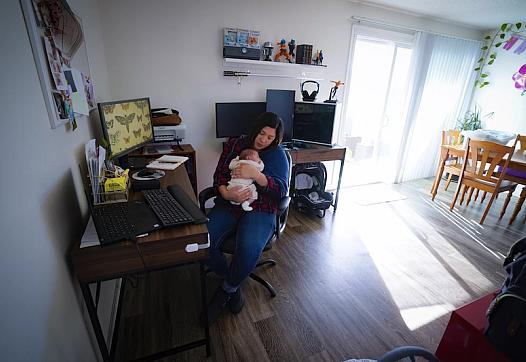Could a new San Francisco tax be a solution to the child care crisis?
This story was originally published in The San Diego Union-Tribune with support from the 2022 National Fellowship.
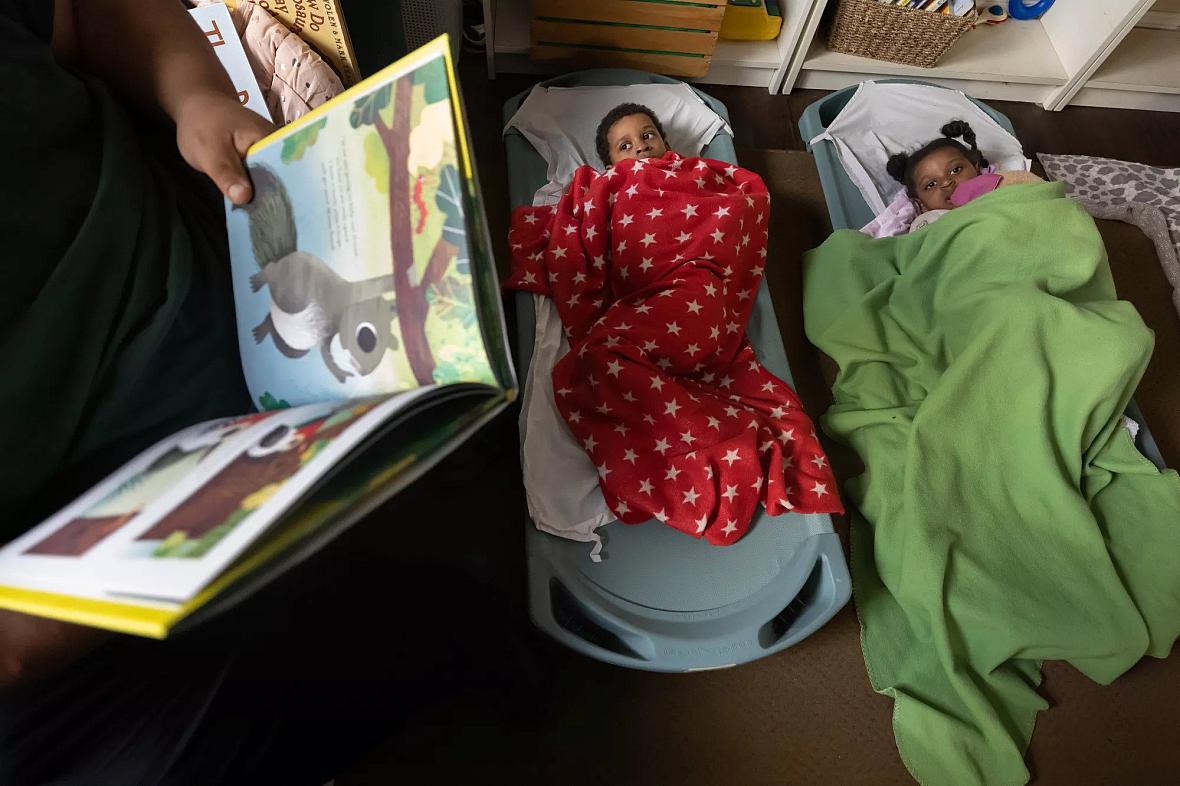
Teacher Matthew Sullivan reads a story to the children during nap time at the Baby Steps Nature School on Friday, Nov. 18, 2022, in San Francisco. Baby Steps has been able to raise wages and hire more staff as a result of new funding from the city’s Prop C measure
Paul Kuroda / For The San Diego Union-Tribune
There’s at least one place in California where even households making six figures can get help paying for child care: San Francisco, the state’s most expensive county when it comes to child care.
As providers across the state await reforms for their financially fraught industry, voters in San Francisco have gone ahead and created their own solution: a commercial tax that now generates $180 million in revenue a year for local child care.
“Why did we go after a revenue source? Because that’s the only way we’re going to get ourselves out of this problem,” said Mary Ignatius, an organizer with Parent Voices, a group that advocates for affordable child care and campaigned for the commercial tax.
Child care — crucial for children’s well-being and necessary for many families to work — has long been a market failure in America.
The inherently high cost of quality care causes a chain reaction of challenges for both consumers and providers: Parents can’t access child care because it’s too expensive, especially for infants and toddlers. And because quality care costs more than what parents can pay, providers are in constant financial stress and unable to pay their staff much — which in turn limits how many children they can serve.
The San Francisco tax, narrowly approved by voters in 2018, is that rare example in California of a dedicated, permanent funding source intended to solve those problems.
In the first year of its rollout, the measure has paid for 1,000 more children to enroll in subsidized care, increased wages for 2,500 early education teachers and made 10,000 more children eligible for subsidized care on top of the 15,000 who were before.
“I’m hoping that if people see San Francisco can do it, then why not somewhere else?” said retired San Francisco Board of Supervisors President Norman Yee, the main architect of the tax measure.
In 2018, after months of organizing from local officials, parents and child care workers, San Francisco voters passed the commercial tax with a measure dubbed “Baby Prop C” by a margin of less than one percentage point. A failed legal challenge by taxpayer and business groups delayed its implementation, but last year, funds collected under it began reaching the child care field in July.
As a result, families making up to 110 percent of San Francisco’s area median income — or up to $152,400 a year for a family of four — can now qualify for subsidized child care for their kids under age 4.
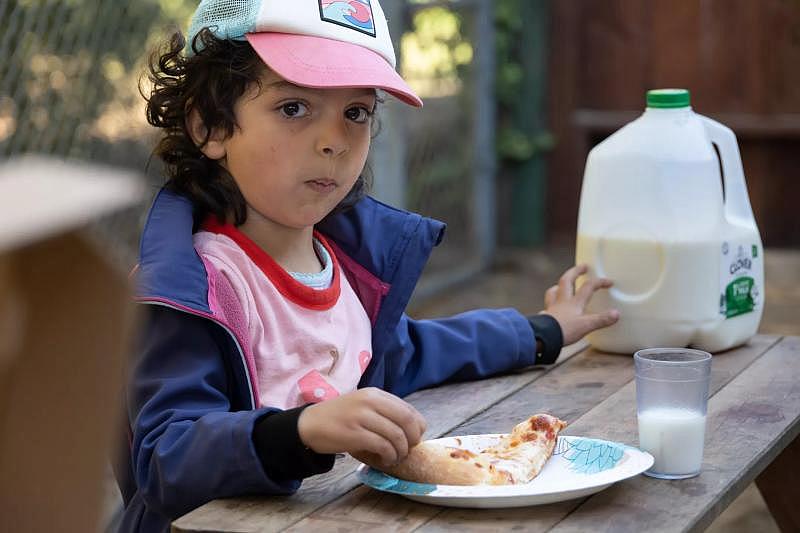
A child eats lunch on Pizza Friday at Baby Steps on Friday, Nov. 18, 2022, in San Francisco.(Paul Kuroda / For The San Diego Union-Tribune)
Those income eligibility rules provide access to far more families than the state’s rules, which only allow subsidized care for families who make up to 85 percent of the state median income — or up to $95,289 annually for a similar family. Because it’s far more expensive to live in San Francisco than in California overall, some families who make even less than what it takes to get by there have not been able to qualify for state-subsidized care.
And unlike the state, which has required many families to chip in an income-based monthly fee toward their subsidized child care, San Francisco plans to charge no fees for city-funded care thanks to Proposition C funding, said Wei-min Wang, a director in the city’s early education department. That’s true even for moderate-income families who are newly eligible, he said.
“Now that we have Baby Prop C money, we don’t have to treat it like a scarce good we have to allocate and ration,” Wang said. “We don’t want high-quality early care and education to be so much a privilege as the right of every child, regardless of your background.”
Eventually, the city’s child care leaders expect to use Prop C to fund subsidized care for families making up to 200 percent of the area median income — as much as $277,100 for a family of four, according to current salary data. But the priority now is serving lower-income families, city officials said.
About half of Prop C revenue goes to expanding access to subsidized child care. But crucially, in an industry where low pay has often thwarted expansion of child care slots, the other half goes to pay raises for child care teachers, who in California are paid on average just $17 an hour. Many in San Francisco were making as little as $18 an hour — far shy of the $31 an hour it takes for a single person to get by there, according to the MIT Living Wage Calculator.
Prop C was designed not only to pay early educators a living wage, but to build a salary structure to put them on par with their counterparts in K-12 education, where starting pay is generally significantly higher and teachers are paid better the more higher education they have.
Prop C is working toward a new minimum wage of $28 an hour for early educators serving at least half low-income children by providing them semi-annual stipends or raising their hourly rates. Advocates expect that will not only improve current teachers’ quality of life but also help draw more quality applicants to the field and thus enable providers to serve more children.
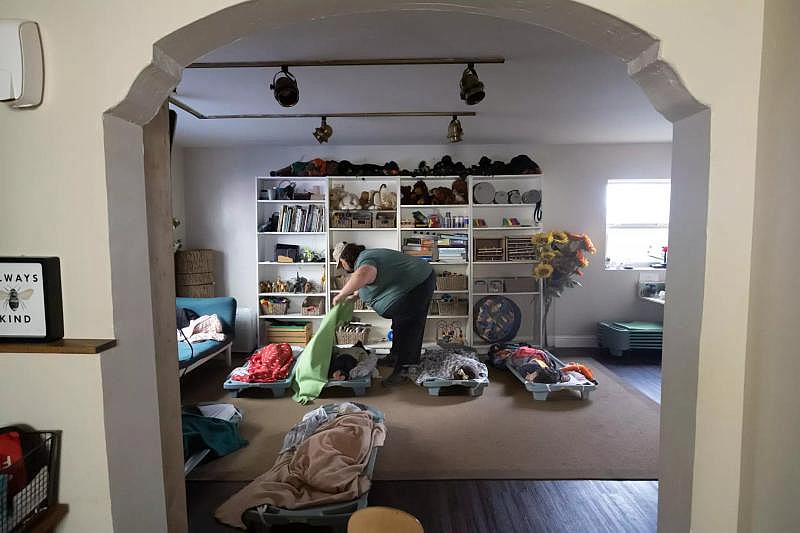
Teacher Matthew Sullivan drapes a blanket over a child during nap time at Baby Steps on Friday, Nov. 18, 2022, in San Francisco, Calif.(Paul Kuroda / For The San Diego Union-Tribune)
It may be too early to judge Prop C’s success.
Still, San Francisco is further along than most of the state in advancing child care reforms. In 1991, San Francisco became what was believed to be the first city in the U.S. to establish a municipal fund exclusively for children’s services, including child care. Since 2004, it has worked toward establishing universal preschool, and since 2013 it has had a city office dedicated to early care and education.
And for more than a decade, the city has paid child care providers who serve low-income kids higher rates than what the state pays its subsidized care providers, knowing that the true cost of providing quality care has typically exceeded what the state pays.
“We now have this dedicated source of early childhood funding that is the first municipal source, where we can really draw from forever,” said Ingrid Mezquita, director of the city’s Department of Early Childhood, of Prop C. “It gives a level of stability that this sector hasn’t had in a very long time, or ever.”
The push for Prop C
Families shell out more for child care in San Francisco than in any other California county.
The vast majority of San Francisco families must pay as much as $2,700 a month — more than $32,000 a year — for full-time infant care, according to a 2021 statewide survey. That’s compared to a statewide average of about $1,600 a month.
Yet California’s income eligibility levels for subsidized care are set so low that many families can’t qualify for help paying for child care, and many families who make enough to get by in California are automatically disqualified from subsidized care because they make too much. In San Francisco, a family of four with two working parents needs to make $167,920 to get by, according to MIT’s Living Wage Calculator, which is more than $72,000 above the state’s income limit for subsidized child care.
Meanwhile, there has not been enough public funding or child care providers in California to accommodate all the children who already do qualify for subsidized care. In San Francisco, more than 2,400 children were on the city’s waiting list for subsidized child care at the time Prop C was being proposed to voters.
There were other reasons to go after a child care tax measure, advocates said. For one thing, child care teachers in city-funded programs were seeing staff turnover rates of 75 percent, according to the early education department, which didn’t bode well for the quality of children’s education.
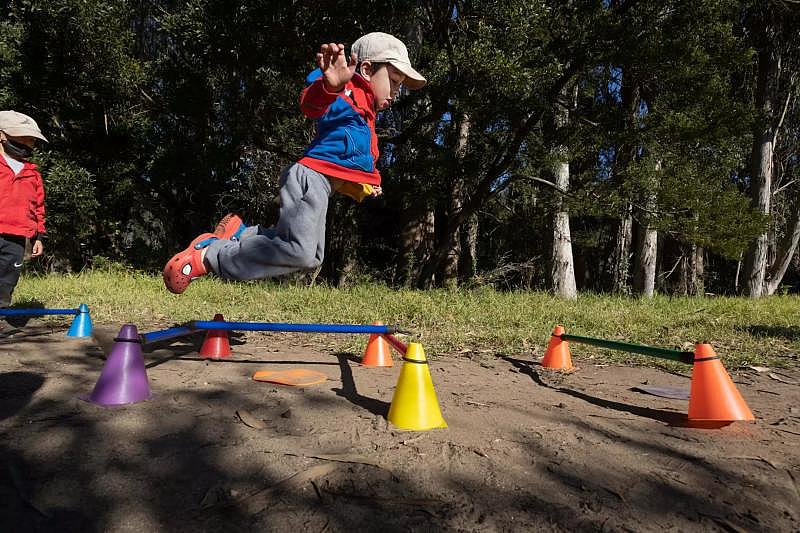
A child leaps during an outdoor activity next to San Francisco’s Stern Grove at Baby Steps on Friday, Nov. 18, 2022.(Paul Kuroda / For The San Diego Union-Tribune)
Prop C was meant to be San Francisco’s answer to those problems.
The measure is largely the brainchild of Yee, the former board of supervisors president and a longtime child care and education advocate who had led one of San Francisco’s two child care referral agencies for 18 years before entering politics. He and fellow Supervisor Jane Kim led the effort to collect more than 9,400 voter signatures to put the initiative on the 2018 ballot.
Before, Yee and other advocates had to keep asking city leaders every year for one or two million or so dollars in the budget for child care. But those incremental, one-time amounts weren’t going to build a better child care system, which would require several reforms, he said.
Those reforms would need to address four areas, he said: giving more families access to subsidized care, expanding facilities to accommodate them, raising teachers’ pay and investing in their professional development to improve quality.
“Prop C is really a game-changer, because it provides the resources to do so many of the things that we wanted to do for our early education system,” Yee said in 2021, after Prop C survived the court challenge. “It gets us to close to universal child care access for everybody, including middle-income families, and it provides living wages for our early care educators.”
Before Prop C, commercial landlords in San Francisco generally paid a commercial rent tax rate of 0.3 percent.
Prop C now collects 3.5 percent from the rents of most commercial spaces and 1 percent from rents of warehouse spaces in San Francisco. Landlords paid less than $1 million annually in rental income and rents paid by government, nonprofit, arts and other tenants are exempt. Fifteen percent of the funds collected by Prop C goes to the city’s general fund, and the rest goes to child care.
It makes sense for large businesses to pay a tax for child care, advocates said, considering they possess some of the city’s greatest wealth and benefit from the availability of such care, since their employees need it to do their jobs. “Business is going to invest and support children in San Francisco so workers can go to work,” said Gina Fromer, CEO of the Children’s Council of San Francisco.
That was a key point supporters made during the 2018 campaign, volunteers said. Parents and providers held rallies, distributed flyers and did phone banking daily, targeting the people who would benefit most, said Maria Luz Torre, a Parent Voices organizer: women and low-income families.
“We even rallied at 555 California (Street). Trump is a co-owner of that building,” she said. “We rallied there to show these are the people who are paying for this, and not you.”
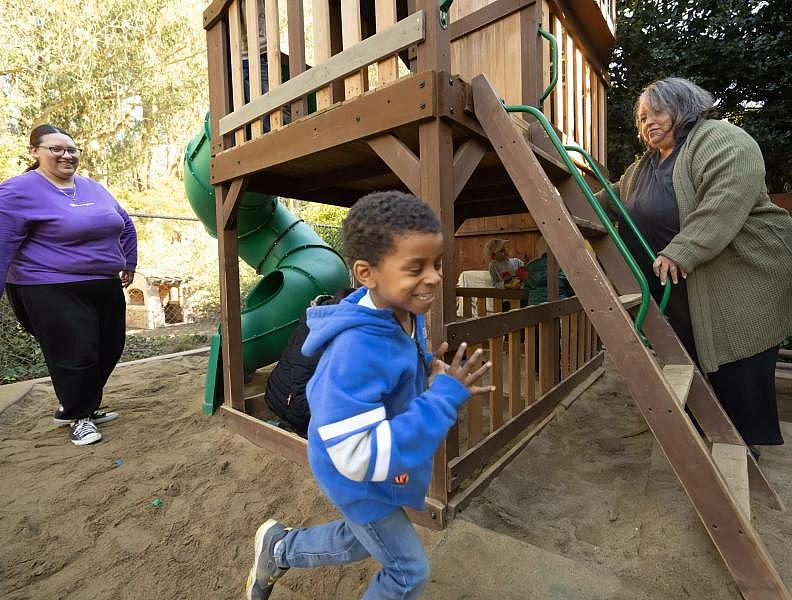
Isabel Daniels (left) and Pat Sullivan (right) run through activities with children at Baby Steps on Friday, Nov. 18, 2022, in San Francisco.(Paul Kuroda / For The San Diego Union-Tribune)
Two months after Prop C passed, a coalition of landlord, business and taxpayer groups that had opposed the measure sued in an attempt to invalidate it. Those groups — the Howard Jarvis Taxpayers Association, Building Owners and Managers Association of California, California Business Properties Association and California Business Roundtable — argued that Prop C actually needed a two-thirds majority to pass because a government official, Yee, had been heavily involved.
“Our issue had nothing to do with where the money was going, but rather that it was an illegal tax,” said Brooke Armour, vice president of the California Business Roundtable, in an email.
But in 2021, a state appeals judge sided with the city, saying that because the measure had been placed on the ballot as a voter initiative — and because Yee’s involvement did not change that — it needed only a simple majority to pass. Later that year, the state supreme court denied the plaintiffs’ request to review their appeal.
San Francisco is lucky, Luz Torre said, in that it has a wealthy tax base to draw from to fund child care. Other counties may have to get more creative, she said.
At least one other California county has also passed a tax to fund child care. In 2020, just across the San Francisco Bay, voters approved a half-percent sales tax in Alameda County to raise child care workers’ wages and offer more subsidized care slots, as well as fund pediatric health care.
That measure, Measure C, has been held up for more than two years by a similar lawsuit. Last July, a trial court judge ruled in the county’s favor. The decision is now being appealed.
Raising wages to raise quality
Prop C is not just about raising pay for teachers, child care leaders said. It’s about professionalizing and improving the quality of a field that has long been underpaid, has often been degraded as babysitting and has lacked greater access to higher education and training.

Teacher Sophia Lam (center) supervises an animal card game with children at Baby Steps on Friday, Nov. 18, 2022, in San Francisco.(Paul Kuroda / For The San Diego Union-Tribune)
Many child care providers have faced obstacles to gaining higher education and professional development, such as language barriers and a lack of money and time. Thirteen percent of family child care providers in California speak only a language other than English, according to the UC Berkeley Center for the Study of Child Care Employment. About half of family child care providers and 20 percent of child care center teachers lack a college degree, according to the UC Berkeley center.
To address this, San Francisco officials have long made their child care funding contingent on providers meeting the city’s quality standards. They plan to use Prop C funds to improve early educators’ access to higher education and training. Some have suggested funding apprenticeships, tuition reimbursement and other programs to build a pipeline of workers that child care, unlike other education fields, has lacked.
The wage increases and stipends that come with Prop C are only available to teachers working for the 416 child care providers and agencies who have met the city’s quality standards and who are willing to serve low-income, subsidized children.
“That’s a foundational requirement for us, because part of the reason why we justify this investment in early childhood education is based on research that shows that high-quality care makes a big difference,” Wang said. “The goal of our department is to get all children to school readiness standards and to make sure that their families are able to have the resources necessary to raise their kids.”
Among those city-required quality standards: Providers must have low adult-to-student ratios, have a certain number of early childhood education college units, and use a developmentally, culturally and linguistically appropriate curriculum approved by the city early childhood department.
To be approved for city child care funding, providers must be visited by independent observers who look for quality interactions between teachers, note areas for improvement and decide whether the program passes a quality test.
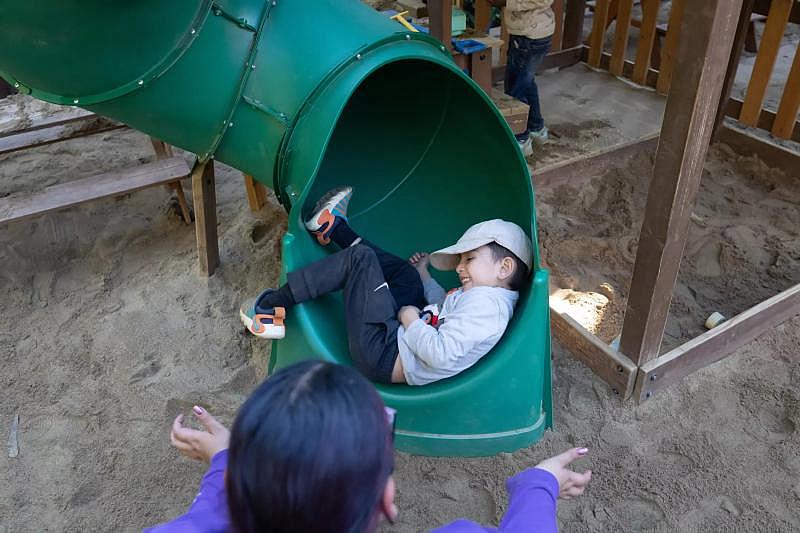
Isabel Daniels (bottom) runs through activities with children at Baby Steps on Friday, Nov. 18, 2022, in San Francisco.(Paul Kuroda / For The San Diego Union-Tribune)
The city department created a new standardized salary structure for early educators, similar to the kind that school districts make for K-12 teachers. The model rewards higher compensation to teachers who serve more subsidized children and who have more higher education or an early childhood teaching permit.
Stipends range from $8,000 annually for full-time assistant teachers who have few or no early childhood education units and serve fewer than 20 percent subsidized children to as high as $39,100 for family child care owners who serve at least 50 percent subsidized children.
By making the funding available only to providers willing to serve subsidized children and boosting pay for those who serve more of those children, the city means to focus Prop C funding on the highest-need programs first, Wang said.
That could also help incentivize more providers to serve low-income, subsidized children. Historically, providers say they have not had much financial incentive to do so, because the state’s subsidized payment rates have been low.
But as providers and advocates statewide have warned, just adding funding for more children to receive subsidized care doesn’t automatically mean more kids will be served. Child care providers have to expand their staffing and facility capacity to take in those additional kids, too.
So San Francisco is budgeting for $35 million of Prop C to be used for child care facilities projects next fiscal year, Wang said.
And the city department continues to encourage child care programs that are not enlisted in the city’s quality network to join. The department offers onsite coaching and funding to new members to improve their facilities and take professional development, Wang said.
There have been challenges in rolling out the Prop C funds.
For one thing, child care programs are still seeing under-enrollment, Wang said. That could be due to parents’ anxiety about spreading sickness, be it flu, RSV or COVID-19. Some families choose to stay with their kids at home or have relatives, friends or neighbors watch them, while others take them to private programs. And child care programs are facing growing competition from public schools, as more children enroll in free transitional kindergarten.
Some programs are also still struggling to hire enough staff. But Wang has heard anecdotally for the first time that they are seeing higher interest and better-qualified applicants for jobs after Prop C. “Staffing is always an issue, but with the wage improvements, it’ll hopefully be less of an issue,” he said.
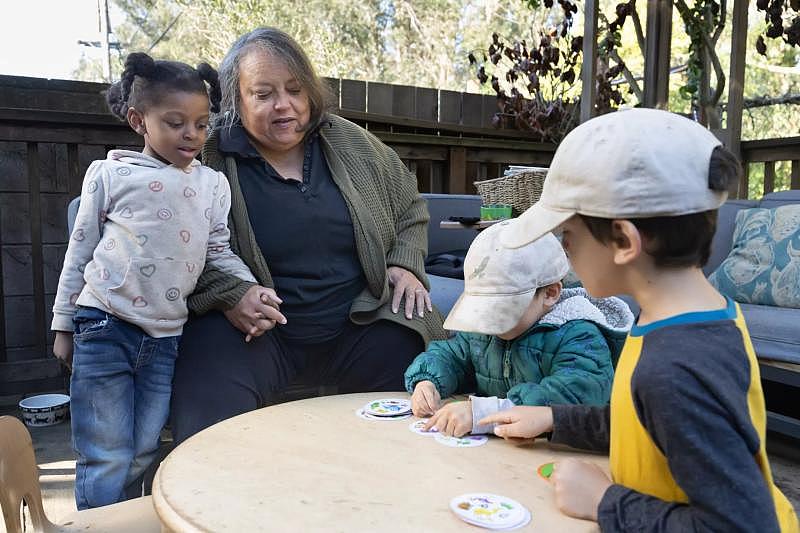
Owner Pat Sullivan (middle) supervises a card game with children at Baby Steps on Friday, Nov. 18, 2022, in San Francisco.(Paul Kuroda / For The San Diego Union-Tribune)
The pay increases have already helped Pat Sullivan, a family child care provider of 30 years who owns the Baby Steps Nature School.
Like many family providers who run small child cares out of their own homes, Sullivan had not been able to pay herself from her business. And since providers can’t charge families more than they can afford to pay — which is far less than the true cost of providing quality care — she was barely breaking even.
To get by, many family providers depend on a spouse’s income. Without one, Sullivan has worked two other jobs on nights and weekends, too, teaching at local colleges. She had been working as much as 80 hours a week between all three.
Prop C changed that.
She was recently able to hire one new full-time teacher and two part-time teachers. She can now pay her teachers $28 an hour, she said, when she previously struggled to pay them $20 an hour.
Now Sullivan has some more time to run her business, rather than just teach children. She still works a lot — but “not the same way, not with the desperation I used to work with,” she said. She’s down to 60-hour weeks.
And finally, Sullivan earns an income from her business.

